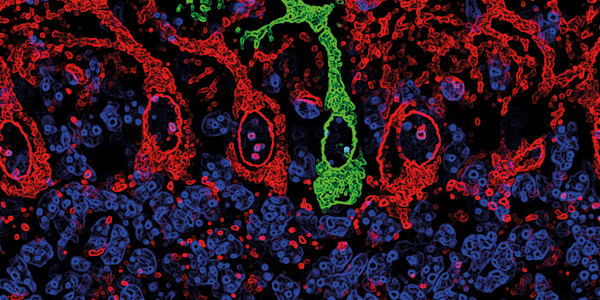A new technique that traces connections between nerve cells has revealed a brand-new way the rabies virus hijacks those connections for its own benefit. Jumping aboard neuronal transport machinery, the virus travels along the neurons in both directions and is able to move much faster than even the proteins for which the transporters are actually intended. This is an exciting discovery not just for rabies research, but because it may present promising new avenues for research into many common neurological conditions, such as Alzheimer’s and Parkinson's diseases.

The rabies virus is the definitive member of the Lyssavirus family, named after the Greek goddess of madness, rage and frenzy. Appropriately, the disease itself is known to present with acute brain inflammation, which causes psychosis and violent aggression, before progressing to the rest of the body where it causes paralysis and failure of organs one by one. If not treated in time, rabies is always fatal, leading to over 55,000 deaths per year globally, according to WHO estimates – but for a disease with such a significant impact, little is known about the way in which the rabies virus actually enters and infects the nervous system. And it has been hypothesized that determining a transport route for the disease could help uncover previously uncharted research territory for more common neurodegenerative disorders.
For the first time, researchers in Germany and Israel have observed a novel mechanism the of entry into the central nervous system (1). Using a pioneering technique for tracing connections between individual neurons, Eran Perlson and Shani Gluska of Tel Aviv University’s Sackler Faculty of Medicine and Sagol School of Neuroscience were able to dynamically track the rabies virus using live cell microscopy as it hijacked its way into the brain through the sensory neurons.
Using the nerve growth factor receptor p75NTR, the rabies virus transports itself through specific types of neurons from its entry site into the brain. p75NTR is a regulator of neuronal survival, development and function. Also implicated in synaptic transmission and axonal elongation, p75NTR binds and transports nerve growth factor and other proteins to perform essential maintenance functions in the central nervous system. So not only is the virus capable of hijacking this axonal transport system for its own needs, but it does so at remarkable velocities of up to 400 mm per day – much faster than the neurotrophins that naturally use the receptor.
Scientists were able to see the virus hijack the p75NTR receptor in real-time by growing peripheral neurons in a controlled system and infecting them with fluorescently-labeled viral particles. They watched the virus enter the cells, replicate in the somata, and then travel in both retrograde and anterograde directions – unique because until now, rabies virus transport has been widely considered to be unidirectional. Now we know that the virus is capable of traveling in either direction along the axon and that, in fact, the newly-discovered anterograde travel takes place via active transport and is more than twice as fast as retrograde travel.
Naturally, this new discovery should pave the way for better treatments for the disease. Its usefulness doesn’t end with rabies, though; the neuron train is disrupted in many neurodegenerative diseases, including Alzheimer’s disease, Parkinson’s disease, and amyotrophic lateral sclerosis, and a better grasp of the neuronal transport machinery may allow researchers to restore and even therapeutically manipulate these processes themselves.
References
- S. Gluska, E.E. Zahavi, M. Chein et al., “Rabies virus hijacks and accelerates the p75NTR retrograde axonal transport machinery”, PLoS Pathog. 10, e1004348, (2014). doi: 10.1371/jounal.ppat.1004348.




